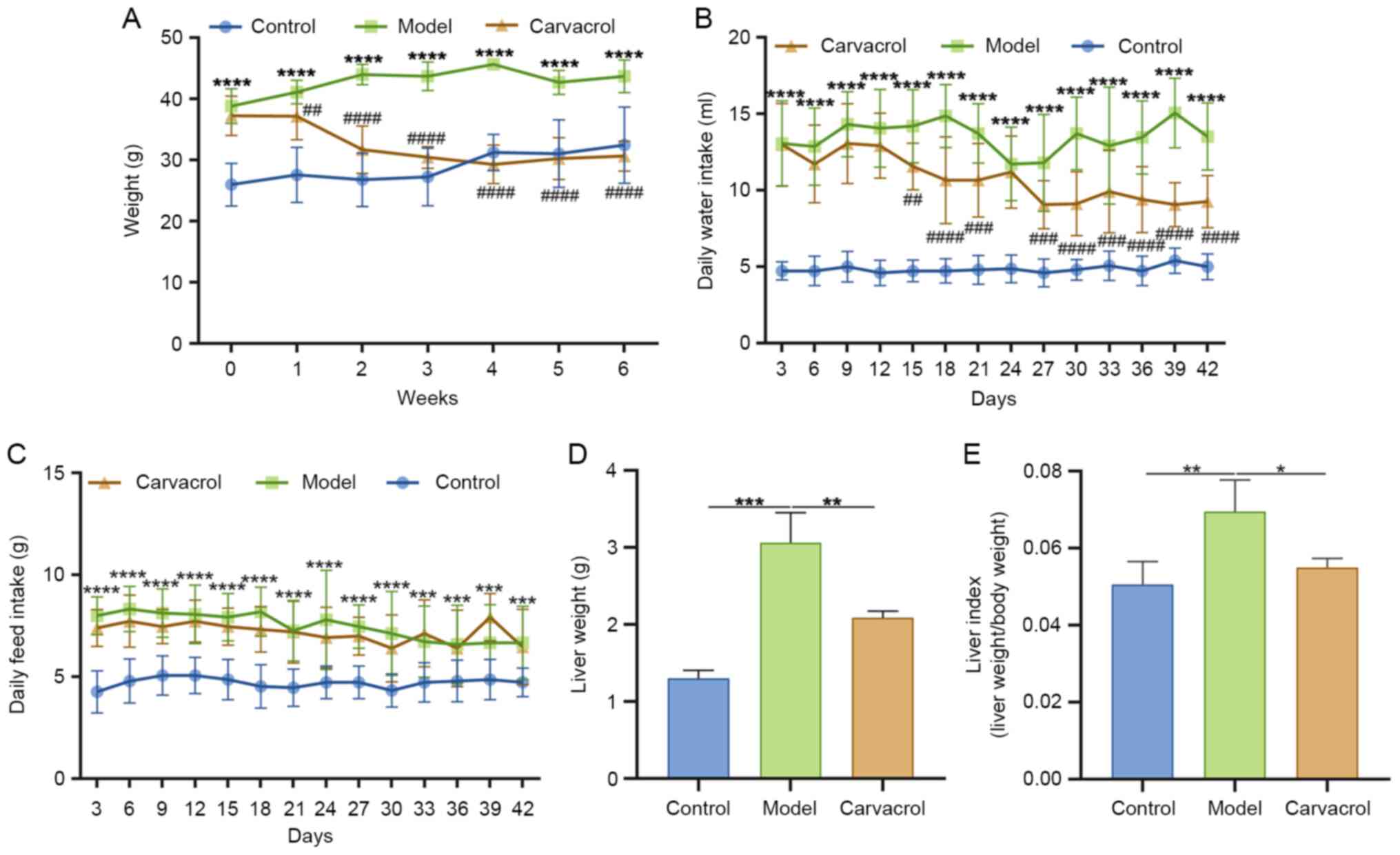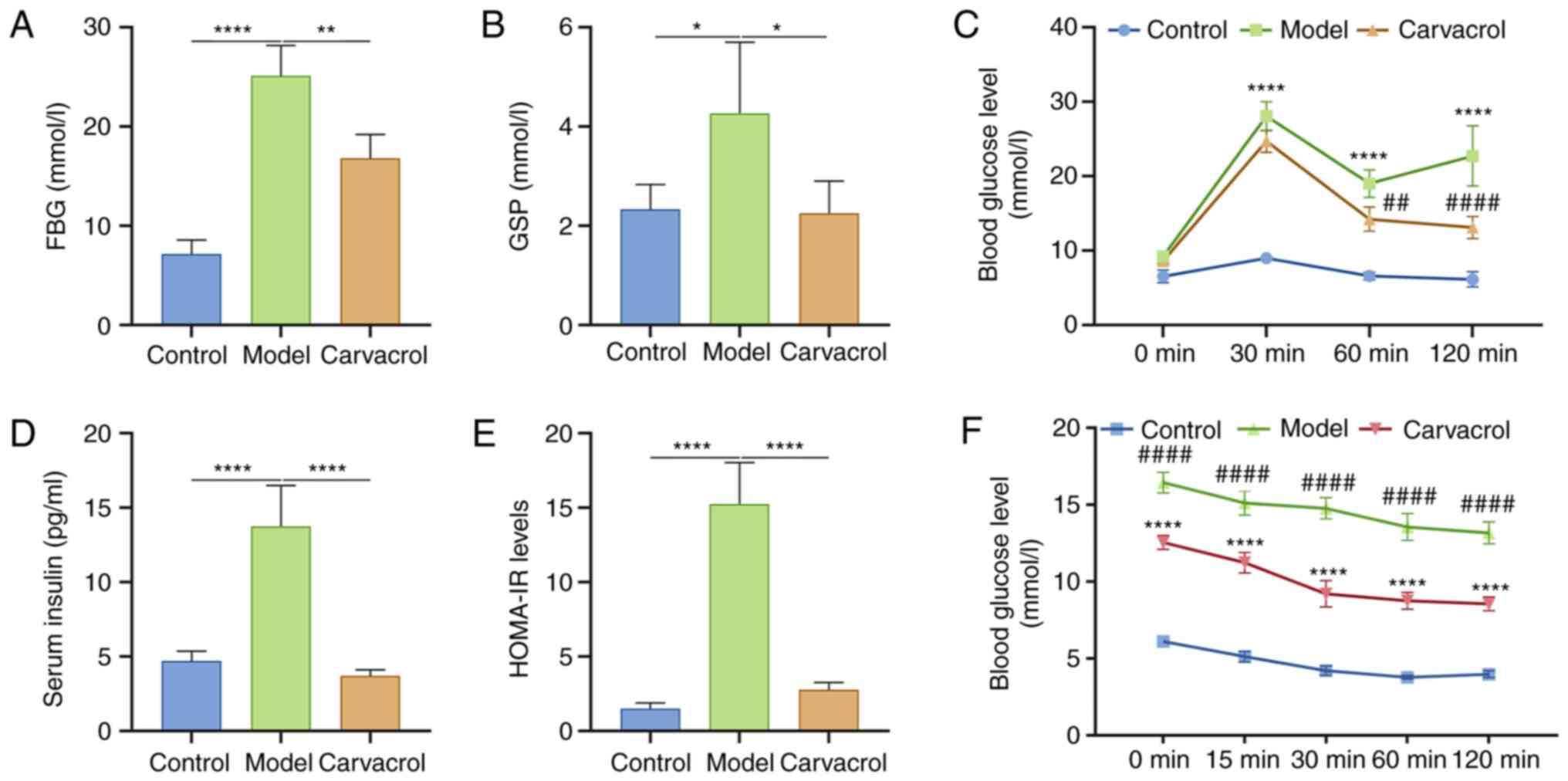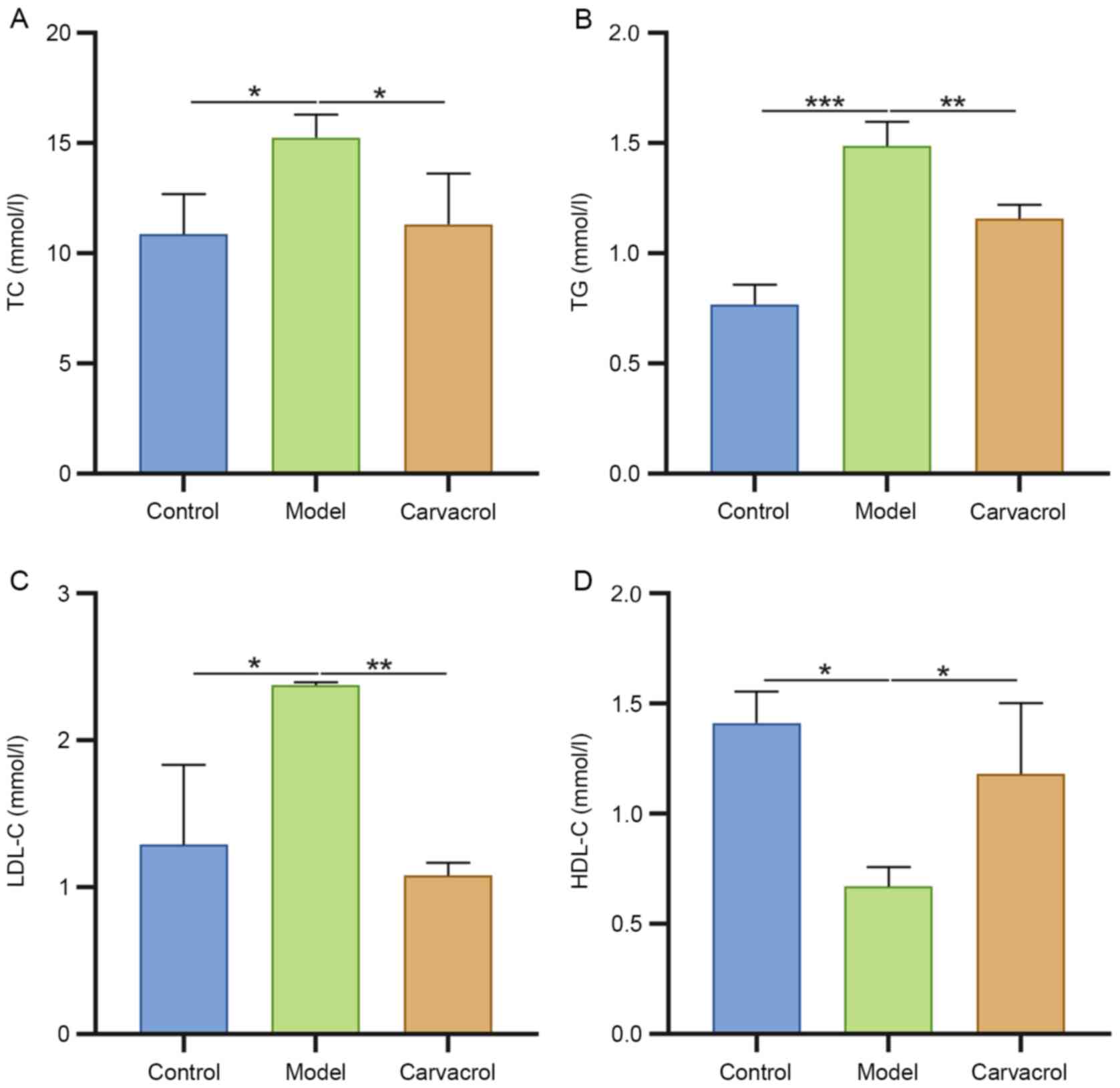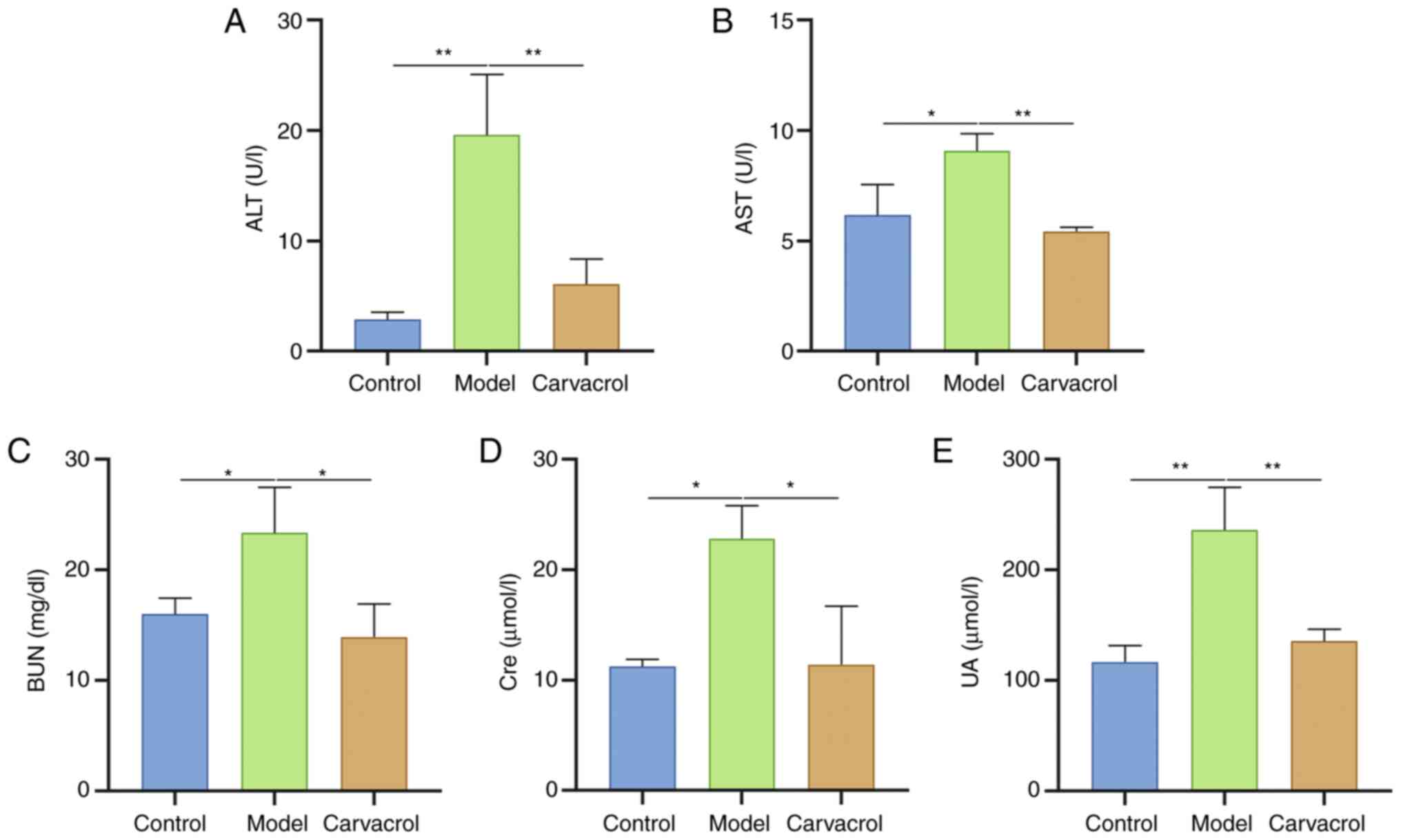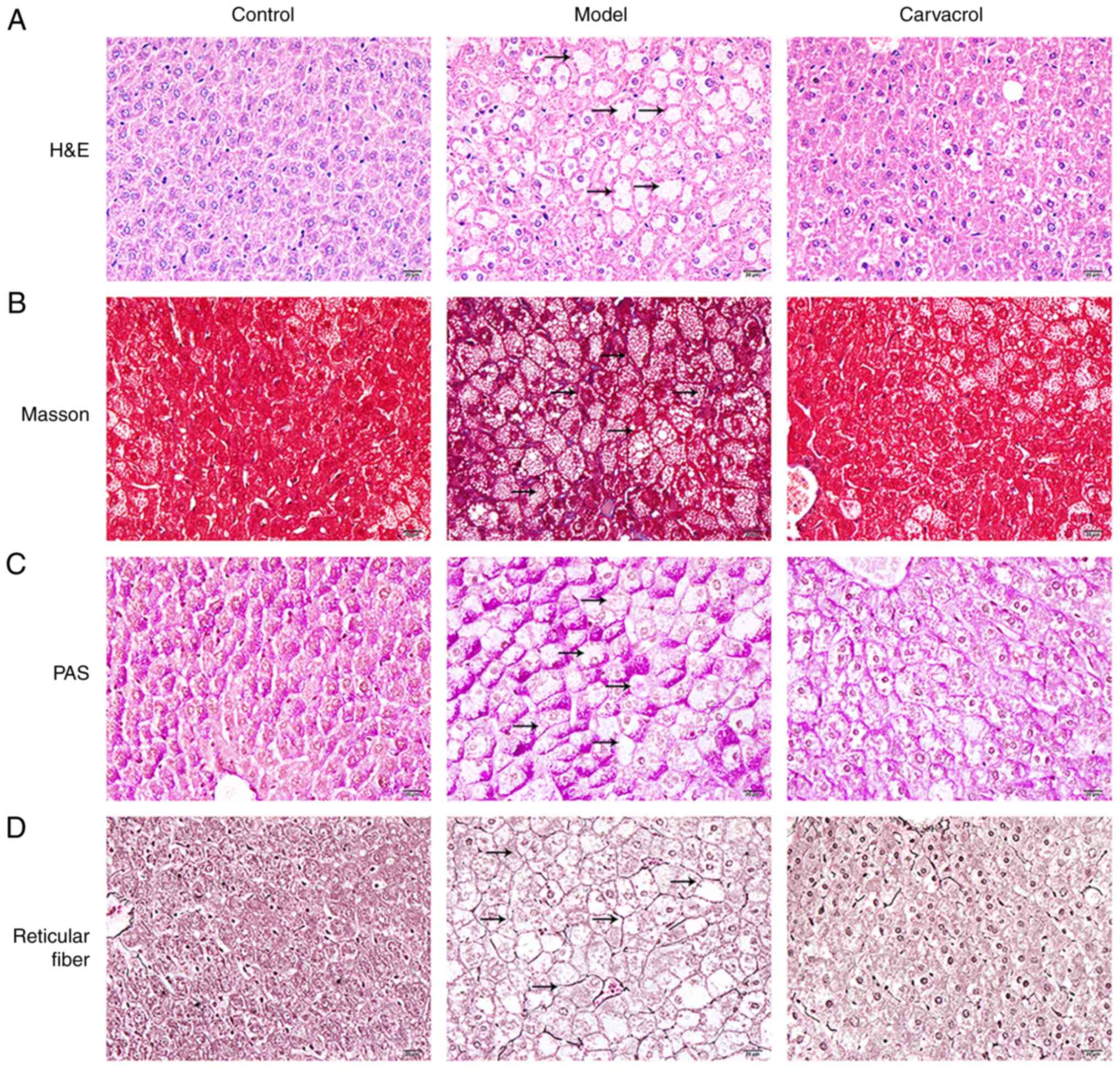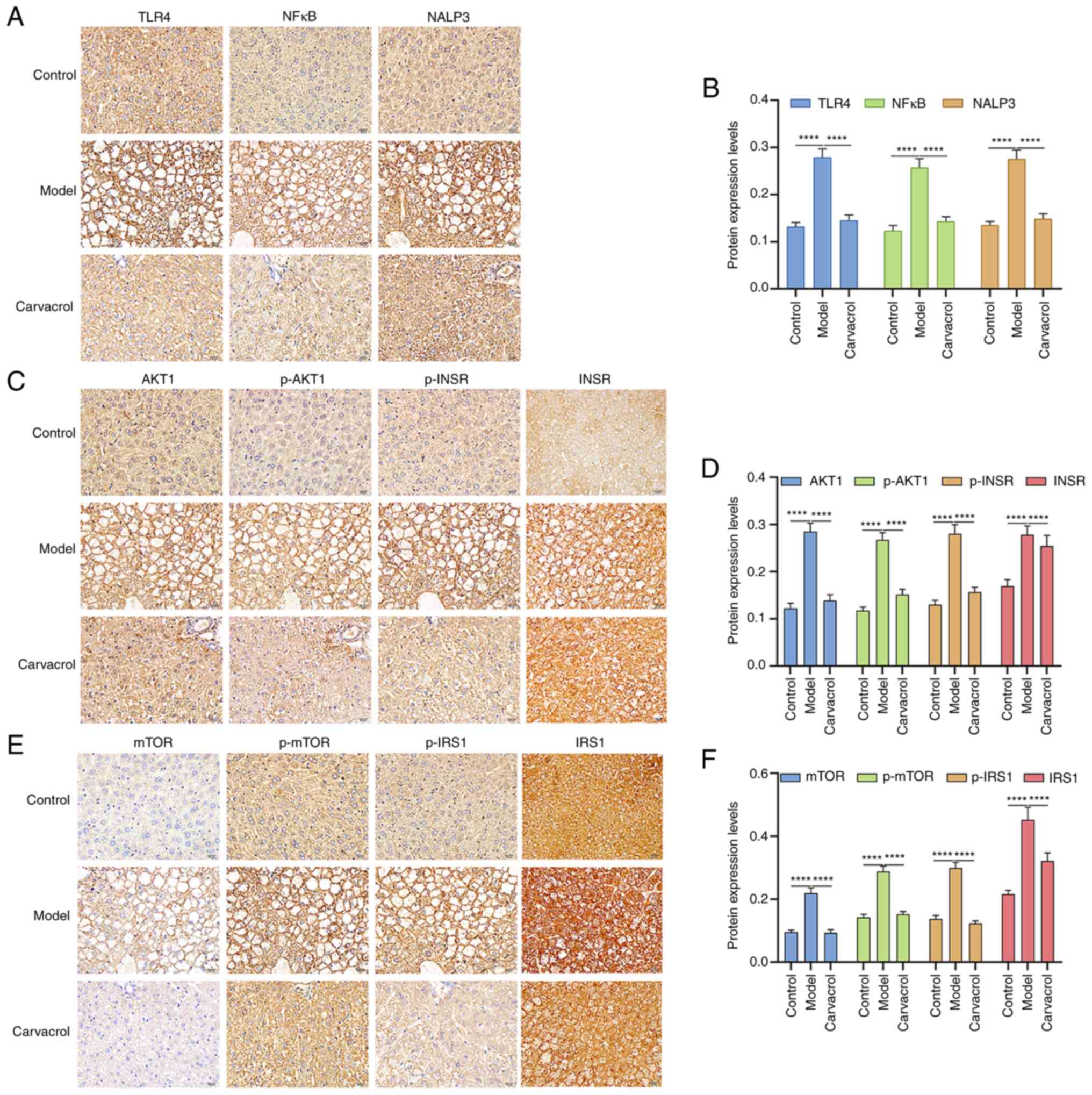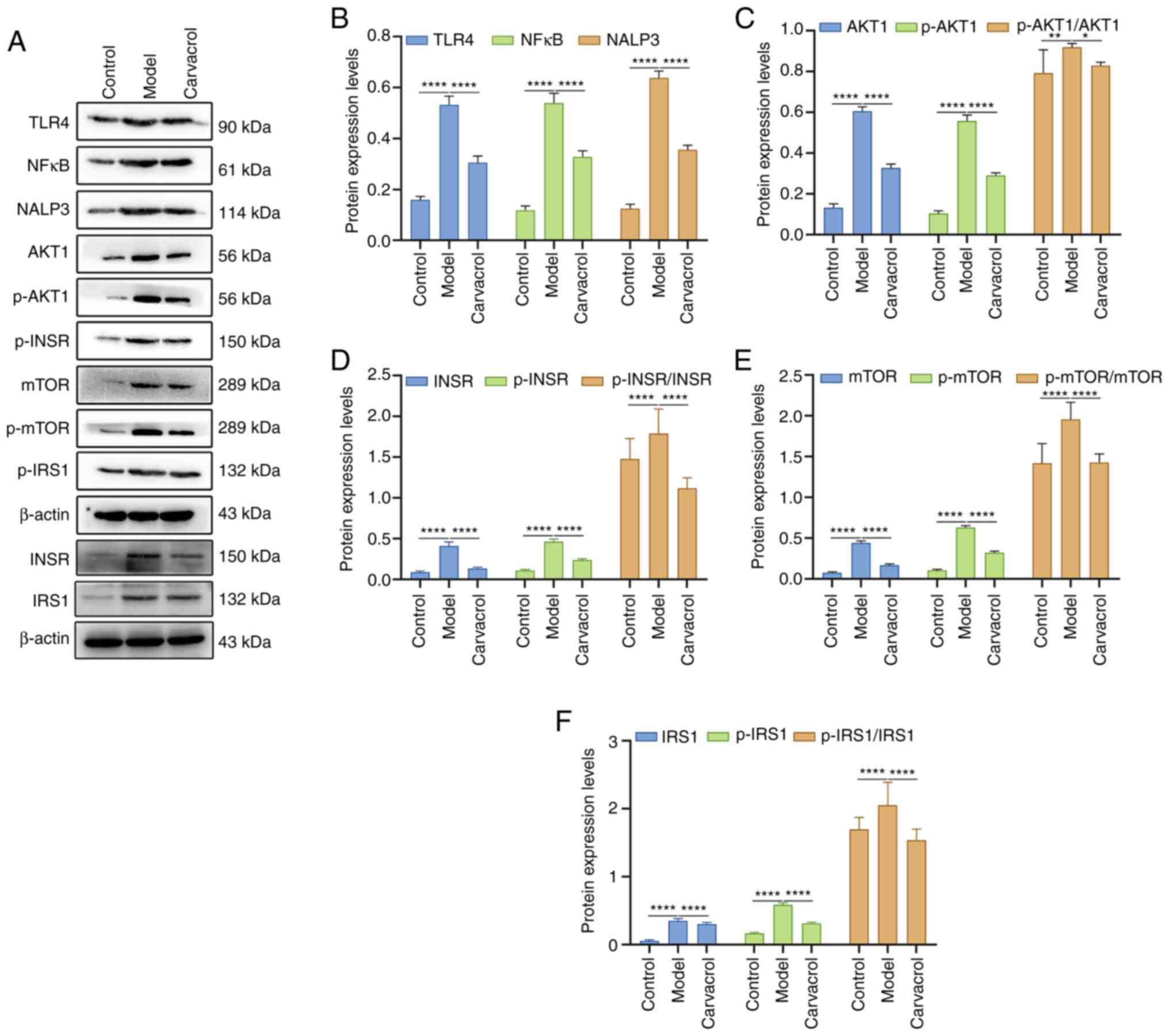Protective effect of carvacrol on liver injury in type 2 diabetic db/db mice
- Authors:
- Published online on: August 24, 2021 https://doi.org/10.3892/mmr.2021.12381
- Article Number: 741
-
Copyright: © Zhao et al. This is an open access article distributed under the terms of Creative Commons Attribution License.
Abstract
Introduction
Type 2 diabetes mellitus (T2DM) is a common chronic metabolic disease (1). It is estimated that there are ~382 million patients with T2DM worldwide. By 2035, it is estimated that the number of patients will be 592 million (2). The liver is one of the target organs affected by long-term hyperglycemia (3). Pronounced insulin resistance and hyperglycemia have been observed in patients with T2DM accompanied by nonalcoholic fatty liver disease (NAFLD) (4). Lipid accumulation caused by insulin resistance can promote the development of NAFLD in patients with T2DM (5–7). Furthermore, inflammation and oxidative stress caused by liver lipid accumulation can accelerate liver cell necrosis and fibrosis (8,9). Currently, the main treatment options for T2DM or NAFLD include exercise, diet, and hypoglycemic and hypolipidemic treatment; however, the therapeutic effects of these strategies remain unsatisfactory (10). Increasing evidence has suggested that the occurrence and development of T2DM-induced NAFLD is associated with a complex pathogenesis and multiple factors (10). There is currently no effective drugs for the treatment of T2DM-induced NAFLD; therefore, there is an urgent need to identify novel drugs to prevent NAFLD caused by T2DM.
Through in-depth research, it has been revealed that numerous active ingredients in traditional Chinese medicine have the potential to relieve NAFLD. Increasing evidence has demonstrated that carvacrol (2-methyl-5-isopropylphenol), a monoterpenic phenol, may possess pharmacological properties, including neuroprotective (11), anti-inflammatory (12), anti-oxidative (13), anti-bacterial (14) and anti-cancer (15) effects. Carvacrol has been reported to relieve T2DM-related complications, such as vascular inflammation (12), hypercontractility in the aorta (16) and diabetic cardiomyopathy (17). Nevertheless, to the best of our knowledge, the effect of carvacrol on T2DM-induced liver injury remains unknown. Because hyperglycemic db/db mice have been widely utilized as T2DM models, the present study chose this method to construct T2DM models (18,19). The present study hypothesized that carvacrol may ameliorate liver injury induced by T2DM.
Materials and methods
Animals
A total of 30 male C57BL/KsJ db/db mice (age, 8 weeks; weight, 32–36 g) and 15 age-matched C57BL/6J control non-diabetic db/m+ mice (weight, 16–18 g) were purchased from Changzhou Cavans Experimental Animal Co., Ltd. (license number: SCXK2001-0003). The mice were maintained under a 12-h light/dark cycle, at 22±3°C and 70±10% humidity; they could freely move and had free access to food and water. The animal experiment was conducted according to the Guide for the Care and Use of Laboratory Animals of the National Institutes of Health (20). The present study was approved by the Animal Care and Ethics Committee of The Second Affiliated Hospital of Guizhou University of Traditional Chinese Medicine (approval no. 2018072; Guiyang, China).
Grouping and administration
All mice were routinely fed for 3 days. The 15 db/m+ mice were employed as the normal control group, and db/db mice were randomly separated into two groups (n=15/group): Model group and carvacrol group. Mice in the model and normal control groups were administered saline daily by gavage. Mice in the carvacrol group were administered an appropriate dose of carvacrol (10 mg/kg) daily by gavage, as previously described (12). After daily treatment for 6 weeks, all mice were fasted for 6 h, but were allowed to drink water. Subsequently, venous blood was obtained from the tail vein and fasting blood glucose was determined using an automatic blood glucose meter (Johnson & Johnson). After taking blood, the mice were euthanized through intraperitoneal injection of 200 mg/kg pentobarbital sodium. Absence of a heartbeat and breathing was used as the criterion for confirming euthanasia of rats. The blood samples were left at room temperature for 2 h, and centrifuged at 3,500 × g for 15 min at 4°C. The supernatant was harvested for serological analysis. In addition, liver tissues were removed and weighed. Liver index was calculated in line with the ratio of liver weight (g) and body weight (g). The tissue specimens were stored at −80°C before further use.
Determination of serum glucose and insulin
Mouse serum insulin concentration was examined using a mouse insulin ELISA kit (cat. no. H203-1-2; Nanjing Jiancheng Bioengineering Institute) according to manufacturer's protocol. The absorbance value was examined at 450 nm using a microplate reader. Homeostasis model assessment of insulin resistance (HOMA-IR) is one of the most common methods used to evaluate insulin resistance (21). HOMA-IR was determined according to the following equation: HOMA-IR=fasting blood glucose (mmol/l) × fasting insulin (mU/l)/22.5, where fasting insulin was detected using the mouse insulin ELISA kit.
Oral glucose tolerance test (OGTT)
After fasting for 6 h, the mice were given an oral glucose solution (1.2 g/kg; body weight). Blood was drawn from the tail vein and blood glucose was determined after glucose administration for 0, 30, 60 and 120 min using a glucose monitor (Ascensia ELITE; Bayer).
Insulin tolerance test (ITT)
ITT was conducted via intraperitoneally injecting 1 U/kg regular insulin (Novo Nordisk A/S) into mice that were fasted for 6 h. Blood glucose levels were determined at 0, 15, 30, 60 and 120 min using a glucose monitor (Ascensia ELITE; Bayer).
Biochemical analyses
Serum alanine aminotransferase (ALT), aspartate aminotransferase (AST), total cholesterol (TC), low-density lipoprotein cholesterol (LDL-C), high-density lipoprotein cholesterol (HDL-C), triglyceride (TG), glycosylated serum protein (GSP), blood urea nitrogen (BUN), creatinine (Cre) and uric acid (UA) levels were separately detected using ALT (cat. no. C009-2-1), AST (cat. no. C010-1-1), TC (cat. no. A111-1-1), LDL-C (cat. no. A113-1-1), HDL-C (cat. no. A112-1-1), TG (cat. no. A110-1-1), GSP (cat. no. A037-2-1), BUN (cat. no. C013-2-1), Cre (cat. no. C011-2-1) and UA ELISA kits (cat. no. C012-2-1) (all from Nanjing Jiancheng Bioengineering Institute) according to manufacturer's protocols.
Hematoxylin and eosin (H&E) staining
Liver tissue specimens were fixed in 4% paraformaldehyde solution at 4°C for 24 h, embedded in paraffin and sectioned. Paraffin-embedded sections (5 µm) were treated with xylene for 20 min twice, absolute ethanol for 5 min twice and 75% ethanol for 5 min at 37°C. The sections were separately stained with 0.5% hematoxylin and 0.5% eosin solution for 5 min at 37°C. Neutral gum was used for sealing and images were captured under an optical microscope (Olympus Corporation). The nucleus was stained blue and the cytoplasm was stained red.
Masson's trichrome staining
Liver tissues were fixed overnight with 10% formalin solution at 4°C and cut into 5-µm sections. Masson's trichrome staining was conducted using the Masson's Trichrome Staining Kit (cat. no. M1340; Beijing Solarbio Science & Technology Co., Ltd.). The tissues were stained with 0.5% Regaud hematoxylin for 10 min at 37°C. After washing for 15 min, 2% Masson lichun red acid complex red fluid was added for 5–10 min. Subsequently, the tissues were stained with 0.5% aniline blue, and then immersed in 1% phosphotungstic acid-phosphomolybdic acid solution for 15 min. The tissues were then washed with 1% glacial acetic acid solution for 5 min, and were further washed with 1% glacial acetic acid solution, dehydrated, permeabilized and sealed in neutral resin. Images were captured under a light microscope (Olympus Corporation). The nuclei were stained black and the collagen fibers were stained blue.
Reticular fiber staining
Liver tissues were fixed overnight with 10% formalin solution at 4°C and cut into 5-µm sections. Liver sections were incubated with 0.5% potassium permanganate for 3 min, and 2% oxalic acid and 2% ferric ammonium sulfate for 1 min at 37°C. Subsequently, the sections were treated with ammonia silver solution for 5 min and 10% formaldehyde solution for 30 sec. The sections were then incubated with the gold chloride solution for 5 min, and sodium thiosulfate for 2 min. Finally, the sections were stained with 0.5% eosin staining solution for 30 sec, and images were captured under a light microscope (Olympus Corporation) and were analyzed using Image-Pro Plus 6.0 software (Media Cybernetics, Inc.).
Periodic acid Schiff (PAS) staining
Liver tissues were fixed, embedded and sectioned as they were prior to H&E staining. Paraffin-embedded sections were stained with 1% periodic acid for 15 min, 1% Chevron dye for 30 min and 0.5% hematoxylin for 3–5 min at 37°C. Images were captured under a light microscope (Olympus Corporation). The glycogen was stained purple-red and the cell nuclei were stained light blue.
Immunohistochemistry
Liver tissues were fixed overnight with 10% formalin solution at 4°C and cut into 5-µm sections. Liver tissue sections were blocked with 5% skimmed milk powder for 1 h at 37°C. Subsequently, the sections were incubated with the following primary antibodies: Toll-like receptor 4 (TLR4; 1:100; cat. no. ab13556; Abcam), NF-κB (1:100; cat. no. 10745–1-AP; Proteintech Group, Inc.), NALP3 (1:100; cat. no. bs-6655R; BIOSS), AKT1 (1:150; cat. no. 10176-2-AP; Proteintech Group, Inc.), phosphorylated (p)-AKT1 (1:100; cat. no. 66444-1-Ig; Proteintech Group, Inc.), insulin receptor (INSR; 1:80; cat. no. ab69508; Abcam), p-INSR (1:80; cat. no. bs-16680R; BIOSS), mTOR (1:100; cat. no. 20657-1-AP; Proteintech Group, Inc.), p-mTOR (1:200; cat. no. ab109268; Abcam), insulin receptor substrate 1 (IRS1; 1:100; cat. no. ab245314; Abcam) and p-IRS1 (1:100; cat. no. bs-3200R; BIOSS) at 4°C overnight. Subsequently, sections were incubated with secondary antibodies (1:500; cat. nos. ab205719 and ab6721; Abcam) for 1 h at 37°C, followed by staining with DAB for 5 min and hematoxylin for 2 min at 37°C. Images were captured under a light microscope (Olympus Corporation).
Immunofluorescence
Liver tissues were fixed overnight with 10% formalin solution at 4°C and cut into 5 µm sections. Liver tissue sections were blocked with 5% skimmed milk powder for 1 h at 37°C treated with unconjugated primary antibodies, as follows: NALP3 (1:100; cat. no. bs-6655R; BIOSS), mTOR (1:100; cat. no. 20657-1-AP; Proteintech Group, Inc.), p-mTOR (1:200; cat. no. ab109268; Abcam), TLR4 (1:100; cat. no. ab13556; Abcam), AKT1 (1:150; cat. no. 10176-2-AP; Proteintech Group, Inc.) and p-AKT1 (1:100; cat. no. 66444-1-Ig; Proteintech Group, Inc.) overnight at 4°C. After washing with TBS-0.3% Tween-20 (TBST), sections were incubated with secondary antibodies (1:500; cat. nos. ab150077 and ab150113; Abcam) at room temperature for 2 h. Images were captured under an immunofluorescence microscope.
Western blotting
Tissues were lysed using RIPA lysis buffer (Beyotime Institute of Biotechnology) plus phosphatase and protease inhibitors on ice. After centrifugation at 12,000 × g for 15 min at 4°C, the supernatant was harvested. Protein concentration was examined using the BCA method (Pierce; Thermo Fisher Scientific, Inc.). Subsequently, 120 µg protein was loaded per lane, samples were separated by SDS-PAGE on 10% gels and were transferred onto PVDF membranes (cat. no. IPVH00010; EMD Millipore). The membranes were blocked with 5% skimmed milk powder for 2–3 h at room temperature. The membranes were then incubated with the following primary antibodies: TLR4 (1:1,000; cat. no. ab13556; Abcam), NF-κB (1:1,000; cat. no. 10745-1-AP; Proteintech Group, Inc.), NALP3 (1:500; cat. no. bs-6655R; BIOSS), AKT1 (1:1,000; cat. no. 10176-2-AP; Proteintech Group, Inc.), p-AKT1 (1:500; cat. no. 66444-1-Ig; Proteintech Group, Inc.), INSR (1:400; cat. no. ab69508; Abcam), p-INSR (1:400; cat. no. bs-16680R; BIOSS), mTOR (1:2,000; cat. no. 20657-1-AP; Proteintech Group, Inc.), p-mTOR (1:1,000; cat. no. ab109268; Abcam), IRS1 (1:500; cat. no. ab245314; Abcam), p-IRS1 (1:500; cat. no. bs-3200R; BIOSS) and β-actin (1:1,000; cat. no. bs-0061R; BIOSS) at 4°C overnight. After washing three times with TBST, the membranes were incubated with secondary antibodies (1:2,000; cat. nos. ab205719 and ab6721; Abcam) at room temperature for 1 h. Blots were visualized utilizing an ECL kit (cat. no. KGP1121; Nanjing KeyGen Biotech Co., Ltd.) and a gel image detection analyzer (Invitrogen; Thermo Fisher Scientific, Inc.). The results were semi-quantified using ImageJ software (version 1.48; National Institutes of Health).
Statistical analysis
GraphPad Prism 8.0 (GraphPad Software, Inc.) was utilized for statistical analysis. Data are presented as the mean ± standard deviation and each assay was repeated at least three times. One-way ANOVA was used for multiple comparisons, followed by Tukey's post-hoc test. P<0.05 was considered to indicate a statistically significant difference.
Results
Carvacrol decreases body weight, liver weight and liver index of db/db mice
Compared with in the control group, the body weight of db/db mice was significantly increased (Fig. 1A). Following treatment with 10 mg/kg carvacrol, the body weight of db/db mice was gradually decreased. Compared with that in the control group, db/db mice had a significantly higher daily intake of water (Fig. 1B) and feed (Fig. 1C). Notably, carvacrol treatment could ameliorate daily water intake for db/db mice; however, there was no significant difference in feed intake between the model and carvacrol groups. Furthermore, liver weight and liver index of db/db mice were significantly increased compared with those in the control group (Fig. 1D and E). After 6 weeks of treatment with 10 mg/kg carvacrol, these two indexes were significantly decreased in db/db mice (Fig. 1D and E). These results revealed that T2DM could increase body and liver weight, which could be reversed by carvacrol treatment.
Carvacrol improves blood glucose and insulin resistance of T2DM db/db mice
Fasting blood glucose and insulin levels can reflect sensitivity to insulin at an overall level (22). Compared with in the control group, the db/db mice exhibited higher fasting blood glucose levels (Fig. 2A). Conversely, after 6 weeks of administration, carvacrol significantly reduced fasting blood glucose levels (Fig. 2A). Furthermore, GSP levels were detected in the three groups. As shown in Fig. 2B, the db/db mice had higher GSP levels compared with those in the control group. Carvacrol administration significantly decreased the levels of GSP in db/db mice. In addition, an OGTT was performed on the mice; as expected, carvacrol markedly decreased the blood glucose levels of db/db mice (Fig. 2C). Furthermore, fasting blood insulin levels were significantly higher in the model group compared with those in the control group (Fig. 2D), which were decreased by carvacrol treatment. HOMA-IR levels were also significantly increased in the model group compared with those in the control group (Fig. 2E). Conversely, HOMA-IR levels were significantly suppressed in db/db mice following carvacrol treatment. The mice also underwent an ITT. As shown Fig. 2F, compared with in the model group, blood glucose levels were significantly decreased in carvacrol-treated db/db mice at 0, 15, 30, 60 and 120 min after insulin injection.
Carvacrol ameliorates dyslipidemia in db/db mice
TC (Fig. 3A), TG (Fig. 3B) and LDL-C levels (Fig. 3C) were significantly increased, and HDL-C levels (Fig. 3D) were significantly decreased in the serum of db/db mice compared with those in the control group. Carvacrol administration significantly reduced serum levels of TC, TG and LDL-C, and increased serum levels of HDL-C in db/db mice, indicating that carvacrol could ameliorate hyperlipidemia of db/db mice.
Carvacrol improves liver and kidney damage in db/db mice
When liver cells are damaged, a large amount of AST and ALT is released from the liver cells into the blood (23). Therefore, serum AST and ALT levels can reflect the severity of liver damage. As shown in Fig. 4A and B, serum ALT and AST levels were significantly higher in db/db mice compared with those in the control group. Following administration with carvacrol, serum ALT and AST levels were significantly reduced in db/db mice, suggesting that carvacrol could improve T2DM-induced liver injury. Furthermore, the renal function of the three groups was assessed. The results revealed that serum BUN (Fig. 4C), Cre (Fig. 4D) and UA levels (Fig. 4E) were significantly higher in db/db mice compared with those in the control group. Conversely, carvacrol treatment significantly lowered these serum levels in db/db mice. These findings demonstrated that carvacrol could improve liver and kidney damage in db/db mice.
Carvacrol protects the liver of db/db mice, as determined through histological examinations
Histological analysis of liver cell injury was performed using H&E staining of the three groups (Fig. 5A). It was revealed that liver injury of db/db mice was more serious compared with that in the control group. Notably, vacuolar degeneration of hepatocytes was detected in db/db mice. Conversely, carvacrol reduced the levels of liver cell damage in db/db mice. Collagen fiber content in liver tissues was detected utilizing Masson's trichrome staining (Fig. 5B). It was demonstrated that control mice exhibited a normal liver lobule structure, whereas obvious hyperplasia of collagen fibers in liver tissue was detected in db/db mice. Following carvacrol treatment, the amount of collagen fiber hyperplasia in the liver tissue of db/db mice was markedly reduced. These findings indicated that diabetes may cause liver fibrosis and carvacrol treatment may improve collagen fiber hyperplasia in the liver tissues of db/db mice. In addition, PAS was performed to detect glycogen in liver cells (Fig. 5C). Compared with in the control group, there was obvious glycogen accumulation in the cytoplasm of liver cells in db/db mice, whereas carvacrol treatment markedly ameliorated glycogen accumulation in liver cells. In addition, as shown in Fig. 5D, obvious reticular fiber hyperplasia was detected in the liver tissues of db/db mice, which was notably improved by carvacrol treatment.
Effects of carvacrol on insulin, TLR4/NF-κB and AKT1/mTOR signaling pathways in db/db mice
To assess the potential mechanisms underlying the effects of carvacrol on T2DM-induced liver injury, the expression of insulin, TLR4/NF-κB and AKT1/mTOR signaling pathway components were detected in the liver tissue specimens. Immunohistochemistry results demonstrated that TLR4, NF-κB, NALP3 (Fig. 6A and B), AKT1, p-AKT1, INSR, p-INSR (Fig. 6C and D), mTOR, p-mTOR, IRS1 and p-IRS1(Fig. 6E and F) were all highly expressed in the liver tissues of db/db mice compared with those in the control group. Following treatment with carvacrol, the expression levels of these proteins were significantly suppressed in the liver tissues of db/db mice. These data indicated that both total and phosphorylated forms of AKT, mTOR, INSR and IRS1 were activated in the liver tissues of db/db mice and were reduced after carvacrol treatment, thus suggesting that carvacrol may inhibit the expression and phosphorylation of these proteins in db/db mice. Consistently, immunofluorescence results confirmed that the expression levels of NALP3, mTOR, p-mTOR (Fig. 7A and B), TLR4, AKT1 and p-AKT1 (Fig. 7C and D) were higher in the liver tissues of db/db mice compared with those in the control group. Conversely, carvacrol administration significantly decreased the expression levels of these aforementioned proteins in db/db mice. In addition, the expression levels of these proteins were detected in the liver tissues of the three groups using western blotting (Fig. 8A). As expected, the expression levels and the phosphorylated/total protein ratios of these proteins were significantly upregulated in db/db mice compared with those in the control group (Fig. 8B-F). Nevertheless, carvacrol treatment significantly decreased the expression levels and the phosphorylated/total protein ratios of these proteins in db/db mice. These findings indicated that carvacrol could ameliorate T2DM-induced liver injury via insulin, TLR4/NF-κB and AKT1/mTOR signaling pathways.
Discussion
NAFLD has a very high prevalence worldwide and is characterized by increased intrahepatic fat. Obesity and insulin resistance, as the two main causes of T2DM, have been shown to be significantly associated with the early stages of NAFLD, even progressing to more severe steatohepatitis and cirrhosis (24). The present study investigated the function of carvacrol in T2DM-related NAFLD treatment. The results indicated that carvacrol effectively reduced liver damage, fibrosis and liver dysfunction in db/db mice, which was associated with insulin, TLR4/NF-κB and AKT1/mTOR signaling pathways.
In the present study, db/db mice were used as a model of T2DM. It is well known that obesity and T2DM are both risk factors of NAFLD (25). In the present study, db/db mice exhibited high body weight and liver weight, which was ameliorated following treatment with 10 mg/kg carvacrol for 6 weeks. Blood glucose is one of the most important indicators used to observe diabetes-induced liver injury as well as the effect of drug treatment. The present study demonstrated that carvacrol administration could significantly decrease blood glucose levels in db/db mice. A previous study reported that carvacrol treatment had no effect on blood glucose and body weight for db/m+ mice compared with the controls (17), indicating that carvacrol has no toxic effect on healthy mice. Insulin resistance is a main therapeutic target for T2DM (26). In the present study, carvacrol significantly decreased serum insulin and HOMA-IR levels of model mice. Important indicators of blood lipid analysis include TC, TG, LDL-C and HDL-C (27). TG is the main energy storage unit of the human body and is an important source of energy for day-to-day activities. However, the continuous high concentration of TG in serum may lead to excessive accumulation in liver cells and can cause fatty liver disease (28). Notably, carvacrol treatment significantly lowered serum TC, TG and LDL-C levels, and increased HDL-C levels in db/db mice, suggesting that carvacrol could ameliorate dyslipidemia.
High concentrations of AST and ALT exist in liver cells; ~80% of AST is contained in the mitochondria and ALT is only distributed in the cytoplasm (29). If liver cells are seriously damaged, AST and ALT are released into the blood; therefore, serum AST and ALT levels are important indexes for liver injury. In the present study, db/db mice exhibited high serum AST and ALT levels, suggesting liver cell damage. Conversely, carvacrol significantly ameliorated liver function in db/db mice, indicating that carvacrol may possess a certain protective effect on the liver. In a previous study, obese diabetic db/db mice manifested renal injury (30). The present findings indicated that carvacrol could improve renal function of db/db mice. Furthermore, the results of pathological analysis demonstrated that severe liver steatosis and fibrosis was present in db/db mice; however, following administration of carvacrol for 6 weeks, liver steatosis and fibrosis were markedly ameliorated. In NAFLD, steatosis has been reported to be present in >5% of liver cells in human patients (31). It has been reported that carvacrol could relieve the progress of carbon tetrachloride-induced rat liver fibrosis; this was associated with Hippo and TGF-β signaling pathways (32). Furthermore, carvacrol may exert a positive effect on proliferation and regeneration of liver cells following 24 and 48 h of partial hepatectomy (33). These findings suggested that carvacrol could relieve the T2DM-induced liver damage.
Pharmacologically targeting signal molecules is an attractive strategy against T2DM complications (24). The present study revealed that carvacrol administration could ameliorate liver injury in db/db mice, which was associated with insulin, TLR4/NF-κB and AKT1/mTOR signaling pathways. Hyperglycemia, insulin deficiency and insulin resistance are the main features of T2DM (34). As an insulin-sensitive organ, the liver functions in maintaining a systemic glucose metabolism balance (34). The present results indicated that carvacrol could ameliorate liver insulin sensitivity in a mouse model of T2DM by mediating insulin signaling pathway components, including INSR, p-INSR, IRS1 and p-IRS1. A previous study reported that the TLR4/NF-κB pathway may be involved in diabetic liver injury (35). TLR4 is one of the key members of the TLR family, which can activate the innate immune system (36). NF-κB, as a dimeric transcription factor, can induce the expression of inflammation-related cytokines, such as TNF-α and IL-6 (37). The present data suggested that carvacrol could inactivate the TLR4/NF-κB pathway and suppress NALP3 expression in the liver tissues of db/db mice, thereby reducing the inflammatory response. The AKT1/mTOR pathway functions in mediating insulin resistance (38,39). The present study demonstrated that carvacrol could regulate insulin resistance by targeting the AKT1/mTOR pathway.
In conclusion, the present study reported that carvacrol administration could ameliorate liver injury, particularly T2DM-induced dyslipidemia and insulin resistance. Mechanistically, carvacrol could protect the liver in T2DM via insulin, TLR4/NF-κB and AKT1/mTOR signaling pathways. Thus, carvacrol may be considered a promising treatment strategy for T2DM-associated liver injury and the therapeutic effect of carvacrol on T2DM-induced liver injury is worthy of further in-depth research.
Acknowledgements
Not applicable.
Funding
The present study was funded by grants from the National Natural Science Foundation of China (grant no. 81760813) and the Science and Technology Cooperation Plan of Guizhou [Qiankehe LH (2016) grant no.7127].
Availability of data and materials
The datasets analyzed during the current study are available from the corresponding author on reasonable request.
Authors' contributions
WZ conceived and designed the study. LC, HZ and CD conducted most of the experiments and data analysis, and wrote the manuscript. QH, YC, QW and SL conducted a small number of experiments and data analysis, and wrote and revised the manuscript. WZ and LC confirm the authenticity of all the raw data. All authors read and approved the manuscript.
Ethics approval and consent to participate
The present study was approved by the Ethics Committee of The Second Affiliated Hospital of Guizhou University of Traditional Chinese Medicine (approval no. 2018072).
Patient consent for publication
Not applicable.
Competing interests
The authors declare that they have no competing interests.
Glossary
Abbreviations
Abbreviations:
|
T2DM |
type 2 diabetes |
|
NAFLD |
nonalcoholic fatty liver disease |
|
OGTT |
oral glucose tolerance test |
|
ALT |
alanine aminotransferase |
|
AST |
aspartate aminotransferase |
|
TC |
total cholesterol |
|
LDL |
low-density lipoprotein |
|
HDL |
high-density lipoprotein |
|
TG |
triglyceride |
|
GSP |
glycosylated serum protein |
|
BUN |
blood urea nitrogen |
|
Cre |
creatinine |
|
UA |
uric acid |
|
H&E |
hematoxylin and eosin |
|
PAS |
periodic acid-Schiff |
References
|
Liang W, Zhang D, Kang J, Meng X, Yang J, Yang L, Xue N, Gao Q, Han S and Gou X: Protective effects of rutin on liver injury in type 2 diabetic db/db mice. Biomed Pharmacother. 107:721–728. 2018. View Article : Google Scholar : PubMed/NCBI | |
|
Guariguata L, Whiting DR, Hambleton I, Beagley J, Linnenkamp U and Shaw JE: Global estimates of diabetes prevalence for 2013 and projections for 2035. Diabetes Res Clin Pract. 103:137–149. 2014. View Article : Google Scholar : PubMed/NCBI | |
|
Younossi Z, Tacke F, Arrese M, Chander Sharma B, Mostafa I, Bugianesi E, Wai-Sun Wong V, Yilmaz Y, George J, Fan J and Vos MB: Global perspectives on nonalcoholic fatty liver disease and nonalcoholic steatohepatitis. Hepatology. 69:2672–2682. 2019. View Article : Google Scholar : PubMed/NCBI | |
|
Yang H, Yang T, Heng C, Zhou Y, Jiang Z, Qian X, Du L, Mao S, Yin X and Lu Q: Quercetin improves nonalcoholic fatty liver by ameliorating inflammation, oxidative stress, and lipid metabolism in db/db mice. Phytother Res. 33:3140–3152. 2019. View Article : Google Scholar : PubMed/NCBI | |
|
Chang TC, Chiang H, Lai YH, Huang YL, Huang HC, Liang YC, Liu HK and Huang C: Helminthostachys zeylanica alleviates hepatic steatosis and insulin resistance in diet-induced obese mice. BMC Complement Altern Med. 19:3682019. View Article : Google Scholar : PubMed/NCBI | |
|
Leung PS: The Modulatory action of Vitamin D on the Renin-Angiotensin System and the determination of hepatic insulin resistance. Molecules. 24:24792019. View Article : Google Scholar : PubMed/NCBI | |
|
Wang CC, Cheng PN and Kao JH: Systematic review: Chronic viral hepatitis and metabolic derangement. Aliment Pharmacol Ther. 51:216–230. 2020. View Article : Google Scholar : PubMed/NCBI | |
|
Li DJ, Liu J, Hua X, Fu H, Huang F, Fei YB, Lu WJ, Shen FM and Wang P: Nicotinic acetylcholine receptor α7 subunit improves energy homeostasis and inhibits inflammation in nonalcoholic fatty liver disease. Metabolism. 79:52–63. 2018. View Article : Google Scholar : PubMed/NCBI | |
|
Liu C, Liao JZ and Li PY: Traditional Chinese herbal extracts inducing autophagy as a novel approach in therapy of nonalcoholic fatty liver disease. World J Gastroenterol. 23:1964–1973. 2017. View Article : Google Scholar : PubMed/NCBI | |
|
Scheen AJ: Beneficial effects of SGLT2 inhibitors on fatty liver in type 2 diabetes: A common comorbidity associated with severe complications. Diabetes Metab. 45:213–223. 2019. View Article : Google Scholar : PubMed/NCBI | |
|
Guan X, Li X, Yang X, Yan J, Shi P, Ba L, Cao Y and Wang P: The neuroprotective effects of carvacrol on ischemia/reperfusion-induced hippocampal neuronal impairment by ferroptosis mitigation. Life Sci. 235:1167952019. View Article : Google Scholar : PubMed/NCBI | |
|
Zhao W, Deng C, Han Q, Xu H and Chen Y: Carvacrol may alleviate vascular inflammation in diabetic db/db mice. Int J Mol Med. 46:977–988. 2020. View Article : Google Scholar : PubMed/NCBI | |
|
de Carvalho FO, Silva ÉR, Gomes IA, Santana HS, do Nascimento Santos D, de Oliveira Souza GP, de Jesus Silva D, Monteiro JC, de Albuquerque Júnior RLC, de Souza Araújo AA and Nunes PS: Anti-inflammatory and antioxidant activity of carvacrol in the respiratory system: A systematic review and meta-analysis. Phytother Res. 34:2214–2229. 2020. View Article : Google Scholar : PubMed/NCBI | |
|
Cardoso AD, Santos EG, Lima AD, Temeyer KB, Pérez de León AA, Costa LM Junior and Soares AM: Terpenes on Rhipicephalus (Boophilus) microplus: Acaricidal activity and acetylcholinesterase inhibition. Vet Parasitol. 280:1090902020. View Article : Google Scholar : PubMed/NCBI | |
|
Trindade GG, Thrivikraman G, Menezes PP, França CM, Lima BS, Carvalho YM, Souza EP, Duarte MC, Shanmugam S, Quintans-Júnior LJ, et al: Carvacrol/β-cyclodextrin inclusion complex inhibits cell proliferation and migration of prostate cancer cells. Food Chem Toxicol. 125:198–209. 2019. View Article : Google Scholar : PubMed/NCBI | |
|
Liu Y, Wei J, Ma KT, Li CL, Mai YP, Qiu XX, Wei H, Hou N and Luo JD: Carvacrol protects against diabetes-induced hypercontractility in the aorta through activation of the PI3K/Akt pathway. Biomed Pharmacother. 125:1098252020. View Article : Google Scholar : PubMed/NCBI | |
|
Hou N, Mai Y, Qiu X, Yuan W, Li Y, Luo C, Liu Y, Zhang G, Zhao G and Luo JD: Carvacrol attenuates diabetic cardiomyopathy by modulating the PI3K/AKT/GLUT4 Pathway in diabetic mice. Front Pharmacol. 10:9982019. View Article : Google Scholar : PubMed/NCBI | |
|
Kobayashi K, Forte TM, Taniguchi S, Ishida BY, Oka K and Chan L: The db/db mouse, a model for diabetic dyslipidemia: Molecular characterization and effects of Western diet feeding. Metabolism. 49:22–31. 2000. View Article : Google Scholar : PubMed/NCBI | |
|
Peng BY, Wang Q, Luo YH, He JF, Tan T and Zhu H: A novel and quick PCR-based method to genotype mice with a leptin receptor mutation (db/db mice). Acta Pharmacol Sin. 39:117–123. 2018. View Article : Google Scholar : PubMed/NCBI | |
|
National Research Council Committee for the Update of the Guide for the C, Use of Laboratory A. The National Academies Collection, . Reports funded by National Institutes of Health. Guide for the Care and Use of Laboratory Animals. National Academies Press; Washington, DC: 2011, PubMed/NCBI | |
|
Emoto M, Nishizawa Y, Maekawa K, Hiura Y, Kanda H, Kawagishi T, Shoji T, Okuno Y and Morii H: Homeostasis model assessment as a clinical index of insulin resistance in type 2 diabetic patients treated with sulfonylureas. Diabetes Care. 22:818–822. 1999. View Article : Google Scholar : PubMed/NCBI | |
|
Prasanna PL, Renu K and Valsala Gopalakrishnan A: New molecular and biochemical insights of doxorubicin-induced hepatotoxicity. Life Sci. 250:1175992020. View Article : Google Scholar : PubMed/NCBI | |
|
Sampath Kumar A, Maiya AG, Shastry BA, Vaishali K, Ravishankar N, Hazari A, Gundmi S and Jadhav R: Exercise and insulin resistance in type 2 diabetes mellitus: A systematic review and meta-analysis. Ann Phys Rehabil Med. 62:98–103. 2019. View Article : Google Scholar : PubMed/NCBI | |
|
Zheng Y, Liu T, Wang Z, Xu Y, Zhang Q and Luo D: Low molecular weight fucoidan attenuates liver injury via SIRT1/AMPK/PGC1α axis in db/db mice. Int J Biol Macromol. 112:929–936. 2018. View Article : Google Scholar : PubMed/NCBI | |
|
Kim KE, Jung Y, Min S, Nam M, Heo RW, Jeon BT, Song DH, Yi CO, Jeong EA, Kim H, et al: Caloric restriction of db/db mice reverts hepatic steatosis and body weight with divergent hepatic metabolism. Sci Rep. 6:301112016. View Article : Google Scholar : PubMed/NCBI | |
|
Eckel RH, Grundy SM and Zimmet PZ: The metabolic syndrome. Lancet. 365:1415–1428. 2005. View Article : Google Scholar : PubMed/NCBI | |
|
Meng Q, Qi X, Fu Y, Chen Q, Cheng P, Yu X, Sun X, Wu J, Li W, Zhang Q, et al: Flavonoids extracted from mulberry (Morus alba L.) leaf improve skeletal muscle mitochondrial function by activating AMPK in type 2 diabetes. J Ethnopharmacol. 248:1123262020. View Article : Google Scholar : PubMed/NCBI | |
|
Berk PD and Verna EC: Nonalcoholic fatty liver disease: Lipids and insulin resistance. Clin Liver Dis. 20:245–262. 2016. View Article : Google Scholar : PubMed/NCBI | |
|
Sattar N, Fitchett D, Hantel S, George JT and Zinman B: Empagliflozin is associated with improvements in liver enzymes potentially consistent with reductions in liver fat: Results from randomised trials including the EMPA-REG OUTCOME® trial. Diabetologia. 61:2155–2163. 2018. View Article : Google Scholar : PubMed/NCBI | |
|
Liu HW, Kao HH and Wu CH: Exercise training upregulates SIRT1 to attenuate inflammation and metabolic dysfunction in kidney and liver of diabetic db/db mice. Nutr Metab (Lond). 16:222019. View Article : Google Scholar : PubMed/NCBI | |
|
Cobbina E and Akhlaghi F: Non-alcoholic fatty liver disease (NAFLD)-pathogenesis, classification, and effect on drug metabolizing enzymes and transporters. Drug Metab Rev. 49:197–211. 2017. View Article : Google Scholar : PubMed/NCBI | |
|
Mohseni R, Karimi J, Tavilani H, Khodadadi I and Hashemnia M: Carvacrol ameliorates the progression of liver fibrosis through targeting of Hippo and TGF-β signaling pathways in carbon tetrachloride (CCl4)-induced liver fibrosis in rats. Immunopharmacol Immunotoxicol. 41:163–171. 2019. View Article : Google Scholar : PubMed/NCBI | |
|
Ozen BD and Uyanoglu M: Effect of carvacrol on IL-6/STAT3 pathway after partial hepatectomy in rat liver. Bratisl Lek Listy. 119:593–601. 2018.PubMed/NCBI | |
|
Ding S, Xu S, Ma Y, Liu G, Jang H and Fang J: Modulatory mechanisms of the NLRP3 inflammasomes in diabetes. Biomolecules. 9:8502019. View Article : Google Scholar : PubMed/NCBI | |
|
Yin H, Huang L, Ouyang T and Chen L: Baicalein improves liver inflammation in diabetic db/db mice by regulating HMGB1/TLR4/NF-κB signaling pathway. Int Immunopharmacol. 55:55–62. 2018. View Article : Google Scholar : PubMed/NCBI | |
|
Liu ZM, Zheng HY, Chen LH, Li YL, Wang Q, Liao CF and Li XW: Low expression of miR-203 promoted diabetic nephropathy via increasing TLR4. Eur Rev Med Pharmacol Sci. 22:5627–5634. 2018.PubMed/NCBI | |
|
Yi H, Peng R, Zhang LY, Sun Y, Peng HM, Liu HD, Yu LJ, Li AL, Zhang YJ, Jiang WH and Zhang Z: LincRNA-Gm4419 knockdown ameliorates NF-κB/NLRP3 inflammasome-mediated inflammation in diabetic nephropathy. Cell Death Dis. 8:e25832017. View Article : Google Scholar : PubMed/NCBI | |
|
Pomytkin I, Krasil'nikova I, Bakaeva Z, Surin A and Pinelis V: Excitotoxic glutamate causes neuronal insulin resistance by inhibiting insulin receptor/Akt/mTOR pathway. Mol Brain. 12:1122019. View Article : Google Scholar : PubMed/NCBI | |
|
Villalobos-Labra R, Silva L, Subiabre M, Araos J, Salsoso R, Fuenzalida B, Sáez T, Toledo F, González M, Quezada C, et al: Akt/mTOR role in human foetoplacental vascular insulin resistance in diseases of pregnancy. J Diabetes Res. 2017:59478592017. View Article : Google Scholar : PubMed/NCBI |



